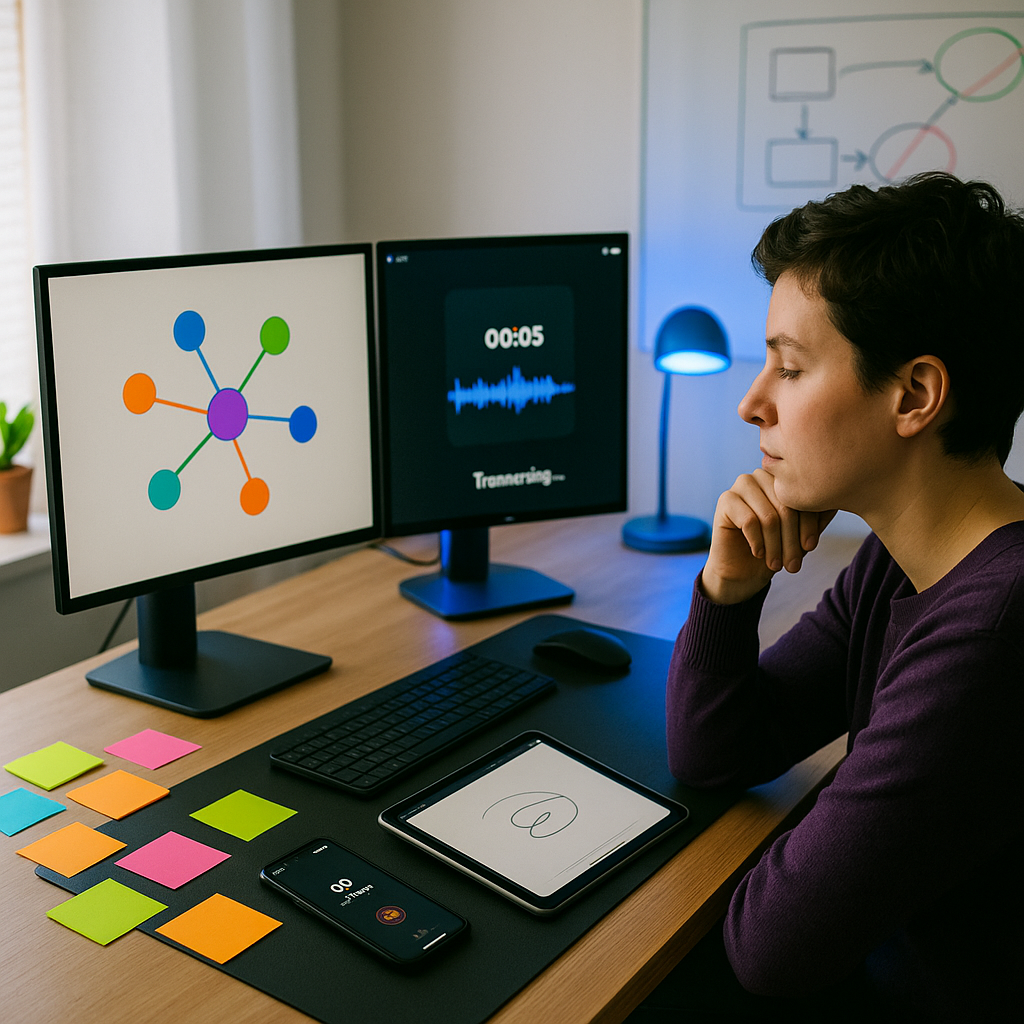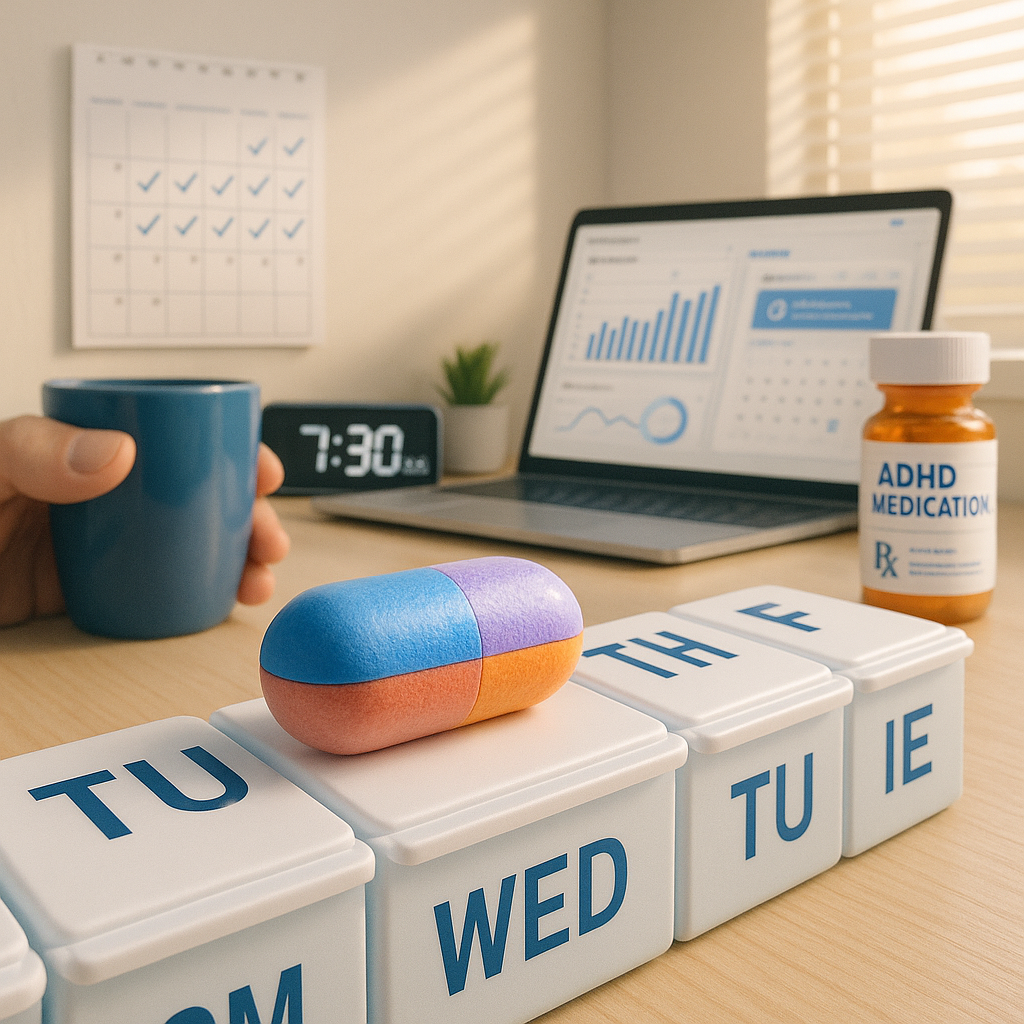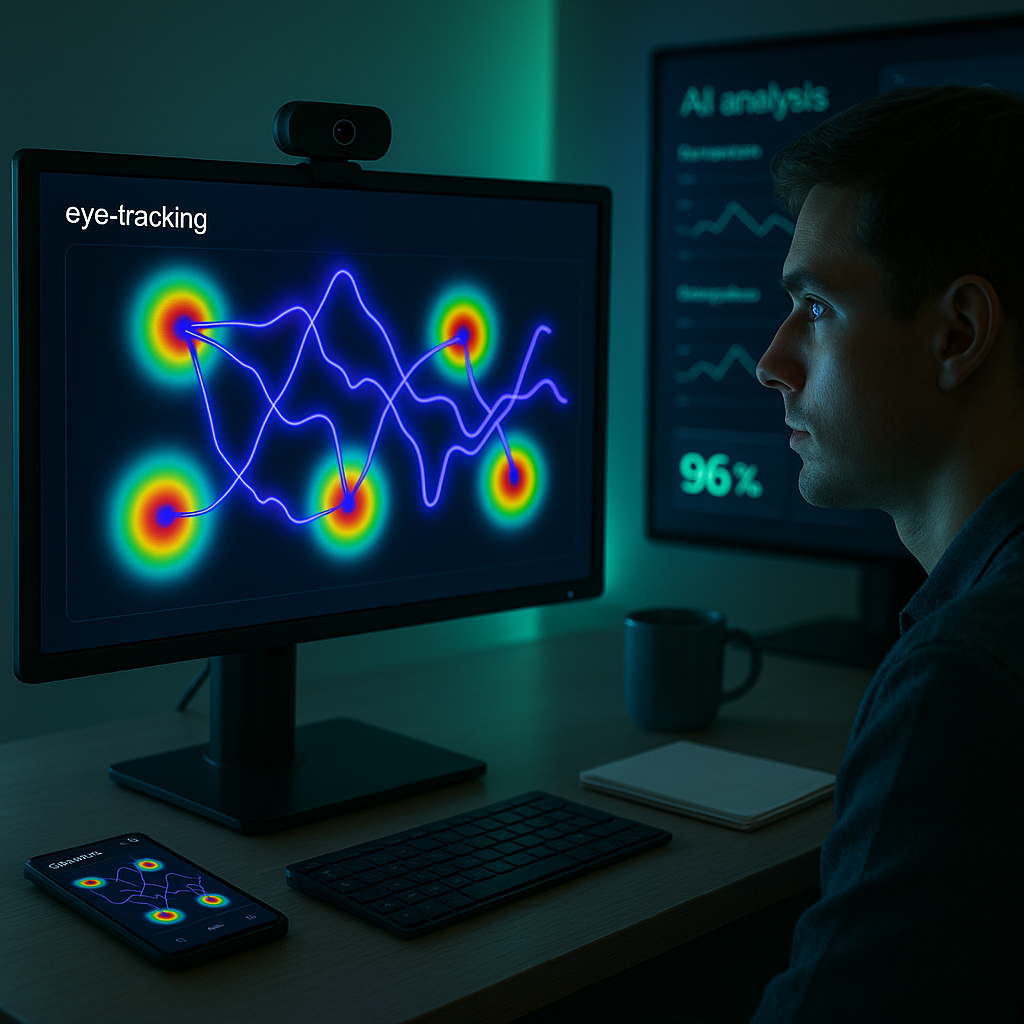Key Takeaways
- Multi-modal inputs fuel creative flow. The best note-taking apps for ADHD creatives are not confined to a single format; they allow effortless switching between visual canvases, voice notes, quick text, and sketches. This adaptability enables you to capture inspiration whether you’re highly focused or operating on low energy.
- Visual organization supercharges recall. Apps that prioritize visual tools (such as digital whiteboards, mind maps, drag-and-drop blocks, and color coding) align with non-linear thinking patterns, enhancing information retention for visual-first minds.
- Voice-to-text bridges energy gaps. Built-in audio recording and transcription features make it possible to capture ideas on the move or during periods of low focus, so note-taking is accessible even when typing feels overwhelming.
- Distraction-free workspaces reduce overwhelm. ADHD-friendly apps offer minimalist interfaces, customizable dashboards, and features that filter digital noise, crafting calmer environments that invite focus instead of adding chaos.
- Workflow integration turns notes into action. Leading apps go beyond simple storage by connecting with calendars, task managers, and project boards. This transforms scattered ideas into actionable steps with minimal resistance.
- AI-powered features amplify clarity. Some modern apps leverage smart tagging, AI summarization, and advanced search tools to automatically organize notes, making retrieval nearly effortless for forgetful minds.
- Flexible retrieval supports shifting attention. Effective systems provide easy ways to return to old ideas using robust search, linking, and tagging. Ideal for moments when your focus or interests shift unexpectedly.
- One-size-fits-all doesn’t work. Tailor your toolkit. Diverse executive function needs call for tailored solutions, whether you seek the blank canvas freedom of GoodNotes, the structured flexibility of Notion, or the instant capture capabilities of Otter. Mixing and matching apps is not just allowed—it’s recommended.
With these diverse options, discovering your ideal note-taking setup can transform chaos into creative momentum. In the following sections, we’ll explore how these platforms empower visual thinkers, intuitive audio-noters, and everyone whose ideas color outside the lines.
Introduction
Selecting the right note-taking app is about far more than staying organized. For ADHD creatives, it means discovering a digital workspace that channels your unique, idea-driven energy. Traditional notebooks and rigid apps often struggle to keep pace with bursts of inspiration—those moments where creativity appears as sketches, scattered voice memos, or color-coded checklists.
The best ADHD note-taking apps refuse to force your thoughts into conventional structures. They celebrate flexibility by offering visual canvases, seamless voice-to-text capture, and intuitive workflow integration. These features do not just enhance your creative process; they strengthen your entire productivity system.
Whether your mind thrives on dynamic mind maps, impromptu audio memos, or the openness of a sketchpad, finding ADHD-friendly digital tools can fundamentally reshape your workflow. Let’s uncover which platforms actually deliver for visual thinkers, audio-noters, and anyone who naturally thinks outside the lines.
Choosing Your Note-Taking System: Understanding the ADHD Brain
Why Traditional Note Apps Often Fall Short
Many mainstream note-taking apps are designed for neurotypical workflows. They assume users can sustain attention, organize thoughts linearly, and consistently maintain complex folder structures. For individuals with ADHD, these expectations rarely match reality.
ADHD minds tend to operate in cycles of hyperfocus and scattered attention. Thinking often happens in webs of connections, not straight lines. Conventional apps that demand strict organization or intricate hierarchies can become sources of frustration, especially as executive function waxes and wanes throughout the day.
The consequence feels all too familiar: abandoned systems, scattered notes across myriad platforms, and the nagging sense that your best ideas slip through the cracks. This is not a failure of motivation; it simply highlights a disconnect between the tool and your natural processing style.
Instead, what works are apps that embrace non-linear thinking, offer diverse ways to capture information, and flex with your mental energy. The ideal note-taking solution doesn’t force you into a predefined box. It adapts to your brain, supporting your creativity and focus in real time.
Core Features That Make a Note App ADHD-Friendly
Not every note-taking app can deliver what the ADHD brain requires. The most supportive ones share a common foundation of features:
Flexible Input Methods
- Versatile text entry for high-focus days
- Effortless voice recording and transcription for periods of low executive function
- Support for images and sketches to capture the visual aspects of your thinking
- Web clipping that preserves full context while browsing
Reduced Friction
- Quick-capture widgets and shortcuts for instant access
- Minimal steps required to record a thought or idea
- Cross-platform synchronization to prevent note loss between devices
- Automatic saving and version control to safeguard your work
Visual Organization
- Intuitive color coding and advanced tagging systems
- Spatial layouts such as kanban boards or mind maps
- Adjustable views (lists, galleries, timelines) for variable focus levels
- Visual cues and icons to lighten cognitive load
Search and Retrieval
- Deep search functions that uncover vaguely remembered information
- Optical Character Recognition (OCR) for pulling text from photos or handwritten notes
- Flexible tagging that doesn’t demand perfect consistency
- AI-powered linking between related notes and themes
The most ADHD-friendly apps are designed to capture first and organize later. They recognize that your most brilliant thoughts need to be recorded in the moment, even if they don’t immediately fit within a rigid system.
Top Apps for Visual Thinkers
Heptabase: The Visual Canvas for Complex Projects
Heptabase is highly recommended for ADHD creatives who excel at connecting dots rather than building categories. Its infinite, scalable canvas lets you visually arrange ideas through cards and linkages, reflecting the natural thinking patterns of neurodivergent minds.
Notable ADHD-supportive features:
- Spatial organization that lets you build visual networks matching how ADHD brains connect concepts
- Universal cards capable of holding text, images, videos, and embedded documents
- Adjustable zoom for both macro overviews and micro-level detail management
- Journal mode for capturing fleeting notes, later organized within your canvas
Heptabase really shines when your thinking is expansive, unstructured, or still in the “idea soup” phase. You can freely capture scattered thoughts now and organize them into innovative frameworks when your executive function rebounds.
One user described their experience:
“Heptabase finally helped me stop losing ideas. I can brain-dump onto my canvas during creative surges, then sort and link them when I have more bandwidth. It’s revolutionized my ability to manage complex projects.”
The primary consideration is its initial learning curve. The setup and feature depth may require some patience, which can be challenging on lower-energy days.
Miro: Collaborative Visual Thinking
For those who work in groups or need to visualize processes with others, Miro provides an exceptionally ADHD-friendly collaborative space. Its vast workspace and visual tools streamline both individual and collective creativity.
Key features for ADHD minds:
- Infinite canvas hosting mind maps, diagrams, and flowcharts
- Drag-and-drop simplicity that reduces mental overhead
- Templates offering just enough structure to guide your process, without feeling restrictive
- Sticky notes and movable elements that adapt as your thinking evolves
Miro is especially helpful for seeing all pieces of a project at once, reducing the “out-of-sight, out-of-mind” challenges common with linear file systems.
A graphic designer with ADHD shares:
“Miro helps me stay on top of everything. I can visualize the whole project, which triggers insights I’d never find with folders or lists alone.”
Miro is best paired with a more text-heavy solution for those projects that require detailed writing or narrative development.
MindNode: Simplified Mind Mapping
MindNode delivers an approachable, visually engaging mind-mapping tool that channels complexity into clarity without overwhelming features.
ADHD-friendly highlights:
- Fast-entry for capturing ideas in real time
- Visually rich, customizable design to keep your brain engaged
- Collapsible branches to manage overwhelm as ideas expand
- Export options for sharing maps with colleagues or clients
This app shines when you need to transform scattered brainstorming into organized, visual frameworks. MindNode’s branching style makes relationships and structure obvious, reducing mental strain.
As one content creator with ADHD explains:
“MindNode keeps my projects on track. I can see the whole ecosystem of my ideas before building it out formally.”
MindNode does focus exclusively on mind mapping, so it’s an excellent add-on tool but not a comprehensive note repository for most users.
Apps for Low Executive Function Days
Otter.ai: When Energy is Low, But Ideas Flow
Otter.ai offers high-quality voice-to-text transcription for those periods when typing or formal organization feels out of reach, preserving creativity without draining resources.
ADHD advantages:
- Real-time transcription for fluid, hands-free capture
- Automatic punctuation and speaker identification
- Highlight and comment functions for easy review during playback
- Fully searchable archives—audio and text remain linked for context
Otter excels during idea floods, those rapid bursts of creativity when capturing every thought seems impossible. With voice capture, you can record everything without pausing for structure or spelling.
A screenwriter with ADHD notes:
“Otter is a game changer. I keep it running during my commute, and now I actually keep my plot ideas instead of losing them to forgetfulness.”
While Otter is fantastic for idea capture, you’ll want to revisit and integrate transcripts into your main organization system when you’re able.
Just Press Record: Simple, Low-Energy Audio Capture
When even opening an app feels like a heavy lift, Just Press Record lets you capture voice notes with just one tap.
Features for ADHD support:
- Easiest possible access, via app, widget, or smartwatch
- Automatic transcription to text
- Cloud sync for secure, everywhere access
- Background recording while using other apps
The simplicity makes this perfect for those days when executive function is nearly depleted, letting you capture thoughts with minimal effort.
A marketing consultant with ADHD says:
“With Just Press Record, I finally save those fleeting ideas. When my brain fails me, this is my backup.”
The trade-off is a lack of deeper organizational controls, so use it as a capture net rather than your sole note manager.
Voice Notes on iOS/Android: Instant, Built-In Capture
Don’t discount the basic voice note apps already present on your smartphone. These offer unmatched accessibility and require no setup.
Benefits include:
- Immediate availability on nearly every device
- No new logins or learning curve
- Direct integration with device search
- Reliably accessible for emergency bursts of inspiration
They’re ideal for on-the-fly recording, perfect for catching ideas that might otherwise vanish due to distractions or energy dips.
A jewelry designer with ADHD reveals:
“I always start with my phone’s voice recorder. It’s fast and foolproof, and later I can move important thoughts to my main notes.”
While limited in organization and transcription capabilities, these tools offer a safety net for high-urgency capture moments.
Conclusion
Building an effective note-taking ecosystem as a neurodivergent professional is less about seeking a perfect app and more about curating tools that reflect the realities of your mind. Rigid, linear note apps often miss the mark for ADHD thinkers because they ignore fundamental needs for flexibility, low entry barriers, and a visually stimulating environment. By embracing platforms offering visual canvases, fast audio capture, and adaptable inputs, you create scaffolding that responds to every phase of your energy. This supports creative peaks and executive function dips alike.
The best ADHD-friendly apps recognize that moments of insight can arrive erratic, rapid, or disorganized. Their secret is making capture effortless so ideas survive long enough to become action and progress. When your tools work like your brain does, you transform overwhelm into momentum. You’re not just recording notes, but fueling personal and professional growth.
Looking ahead, the future of note-taking is not about conformity; it is about empowerment. As more platforms blend artificial intelligence, flexible interfaces, and cross-industry integrations, the opportunities for neurodivergent minds expand dramatically. Your process is not a flaw. It is a source of originality and innovation. The right toolkit will amplify that brilliance. Across every project. Every day. The challenge is not just choosing what works now, but remaining open as technology evolves so your workspace grows with you. Let your creativity lead. The systems and tools will follow, illuminating the unique current that makes your mind exceptional.





Leave a Reply